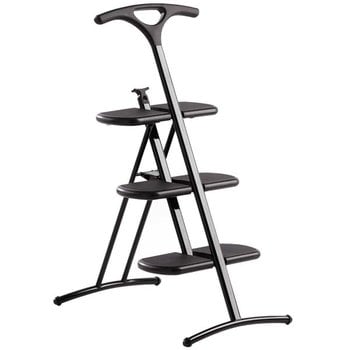Tiramisù stepladders are a functional object to every home. The folding stepladders have a slip-resistant finish. The handles offer support during use, and afterwards the ladders can mounted on the wall. The Tiramisù stepladders by Kartell are designed by Andries Van Onck in 1991.


Tiramisù step ladder, black
Kartell
Description
Tiramisù stepladders are a functional object to every home. The folding stepladders have a slip-resistant finish. The handles offer support during use, and afterwards the ladders can mounted on the wall. The Tiramisù stepladders by Kartell are designed by Andries Van Onck in 1991.
Product details (6)
- Colour
- Black
- Width
- 43 cm
- Depth
- 60 cm
- Height
- 92 cm
- Measurement details
-
Depth: 60 cm open / 7 cm closed
Height: 92 cm open / 101 cm closed - Material
- Painted steel, fibreglass reinforced polypropylene
- Product ID
Designer
The dutch Milan-based designer Andries van Onck (b.1928) was tought by Gerrit Tomas Rietveld before he started studying in Ulm at Hochschule fire Gestaltung. He started his career working as a designer for Olivetti in Italy and opened later his own studio in Milano where his wife Hiroko Takeda joined him. Together they designed numerous furniture, household appliances and electronic products.
Read moreReviews (3)
4.33
Based on 3 reviews
-
A
Anonymous | Verified Customer
Lombard, United States
11 months ago
-
A
Anonymous | Verified Customer
Edmonton, Canada
1 year ago
-
A
Anonyymi | Verified Customer
Eura, Finland
4 months ago
Sustainability
The Product Sustainability Framework, our criteria of sustainable design, helps you find the most sustainable products in our selection. Read below which sustainability criteria this product has met.
Working conditions & labour 9/9
-
Equal opportunities for all employees
-
Commitment to UN Global Compact, fair compensation for all employees
-
Corporate responsibility requirements defined and communicated for suppliers
-
Systematic work for improved inclusion and well-being in the workplace
-
Transparent supply chain
-
Suppliers' compliance to a code of conduct ensured
-
Direct suppliers audited and certified
-
Compliance to the UN Guiding Principles on Business and Human Rights ensured in the supply chain
-
Support for community involvement in the supply chain
Eco-friendly production 8/9
-
Fair and resource-wise water-use in production
-
No incineration or landfilling of returned items
-
No use of endangered species as materials
-
No direct environmental emissions or waste (excl. GHGs) from production
-
The sustainability of direct suppliers' production is addressed and monitored
-
Production and material sourcing that respect biodiversity, animal rights, and natural ecosystems
-
Material-efficient and ecological packaging
-
No potentially harmful chemicals used in own production
Climate impact 4/8
-
Company's direct greenhouse gas emissions identified and commitment to reduction
-
Product's carbon impact identified and commitment to reduction
-
Guidance on energy- and eco-efficient use of the product
-
Contribution to climate initiatives beyond the brand’s direct operations
Sustainable materials 5/6
-
Sustainable and long-lasting material choices
-
No harmful or hazardous substances
-
Responsible raw material sourcing and production
-
Materials suited for circularity: monomaterials, recyclable finishings, renewable or recycled contents etc.
-
Ecological materials: natural, biodegradable, recyclable or recycled contents
Circular design 4/5
-
High aesthetic quality promoting long-term use of the product
-
Technically durable product design and material choices
-
Design for enduring life-long quality
-
Design and support for product maintenance, repair and upgradability





